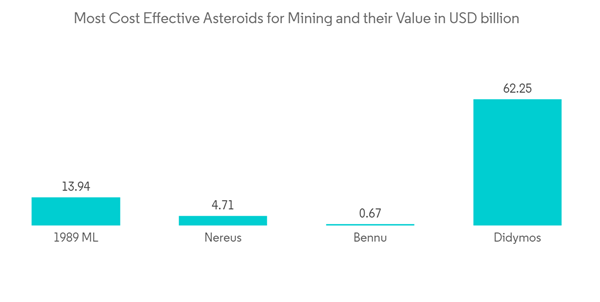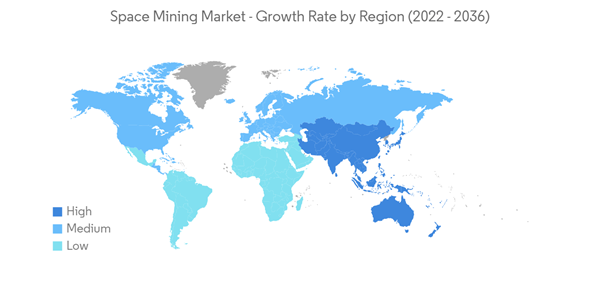The Space Mining Market size is estimated at USD 1.97 billion in 2024, and is expected to reach USD 4.13 billion by 2037, growing at a CAGR of 16.01% during the forecast period (2024-2037).
The COVID-19 pandemic had a negligible impact on the space mining market over the last two years. Although slight delays were observed in the manufacturing sector, most of the space mining programs are back on track with the industry slowly moving toward the commercialization of space mining activities.
Besides the United States, Luxembourg and the United Arab Emirates are racing to develop space mining laws, hoping to attract investment with business-friendly legal frameworks. While China reportedly views space-resource development as a national priority, as part of a strategy to challenge the US economic and security primacy in space, Russia, Japan, India, and the European Space Agency harbor space-mining ambitions of their own.
The development of a global framework, the growing enthusiasm from the private sector, the advent of a feasible space mining technology, and reduction in project costs are expected to radically boost the space mining efforts, which would require mass production of landers and rovers to survey a mining site prior to setting up a mining rig on any celestial body.
On the other hand, the high costs associated with the space mining programs and the technical and technological challenges in space mining may restrict the prospective investors, thereby affecting the growth of the space mining market.
This product will be delivered within 2 business days.
The COVID-19 pandemic had a negligible impact on the space mining market over the last two years. Although slight delays were observed in the manufacturing sector, most of the space mining programs are back on track with the industry slowly moving toward the commercialization of space mining activities.
Besides the United States, Luxembourg and the United Arab Emirates are racing to develop space mining laws, hoping to attract investment with business-friendly legal frameworks. While China reportedly views space-resource development as a national priority, as part of a strategy to challenge the US economic and security primacy in space, Russia, Japan, India, and the European Space Agency harbor space-mining ambitions of their own.
The development of a global framework, the growing enthusiasm from the private sector, the advent of a feasible space mining technology, and reduction in project costs are expected to radically boost the space mining efforts, which would require mass production of landers and rovers to survey a mining site prior to setting up a mining rig on any celestial body.
On the other hand, the high costs associated with the space mining programs and the technical and technological challenges in space mining may restrict the prospective investors, thereby affecting the growth of the space mining market.
Space Mining Market Trends
Government Initiatives to Help the Growth of the Market
Government initiatives are currently helping the growth of the market. Governments are issuing licenses to parties planning to conduct activities in space, and some countries are enforcing new regulations for space mining. The Commercial Space Launch Competitiveness Act, enacted by the United States in 2015, encourages private companies to undertake mining work beyond Earth. In 2020, the US administration created new rules through an executive order following the 2015 law change for how those companies may profit from operations on the Moon, asteroids, and other planets. The administration also plans to encourage other nations to adopt this new US perspective on space mining. Moreover, the Luxembourg space mining law, passed as a part of the SpaceResources initiative in 2017, aims to relax restrictions on private companies' mining operations beyond Earth. Luxembourg became the first country to adopt legal regulations pertaining to mining in space, including from asteroids. The United Arab Emirates is also taking steps to regulate mining for resources in space so private companies can retain full ownership of the mined resources. In 2020, the UAE Space Agency announced the details of the new UAE Space Law that tackles oversee several space-related commercial activities, including mining operations and space logistics services, in addition to the mechanism for dealing with space debris, meteorites, and managing space risks. Japan became the fourth nation in 2021 to lay the legal foundations that favor the incursion of its companies into the commercial exploitation of the Moon, asteroids, and other planets after passing the Law for the Promotion of Commercial Activities Related to the Exploration and Exploitation of Space Resources. Such government initiatives aimed at facilitating the players to take advantage of space mining are expected to encourage them to invest in the highly profitable industry, thereby driving the growth of the market during the forecast period.Asia-Pacific Expected to Witness the Highest CAGR During the Forecast Period
The market is expected to witness the highest CAGR in Asia-Pacific during the forecast period, as several countries in the region started to shift their focus toward the space mining sector. China is engaged in a technological race to thwart the increasing efforts of the United States to dominate space commerce. China's private and state-owned aerospace companies were engaged in a slew of activities recently. In October 2021, the Academy of Aerospace Solid Propulsion Technology (AASPT), a part of the China Aerospace Science and Technology Corporation (CASC), test-fired a solid rocket motor producing 500 tons of thrust. The rocket is designed to propel the next iteration of China's heavy-lift rockets, which would meet various demands for space missions like crewed Moon landings, deep space exploration, and off-world resource extraction. Also, in April 2021, Shenzhen Origin Space Technology Co. Ltd launched the first commercial spacecraft named NEO-1, dedicated to mining space resources, ranging from asteroids to the lunar surface. In addition to China, India has also floated plans about extracting Helium-3 from the Moon. On this note, the Indian Space Research Organization (ISRO) plans to mine Helium-3 rich lunar dust, generate energy, and transport it back to Earth. ISRO's lunar dust mining plan comes in the backdrop of India's plan to cut down import dependence on hydrocarbons by 10 percentage points by 2022. In June 2021, Japan became the fourth country in the world, after the United States, Luxembourg, and the United Arab Emirates, to draft a dedicated law for the exploration and exploitation of space resources. The law permits Japanese private business operators to engage in the exploration and development of space resources, such as water, minerals, and other non-living resources in outer space, on the Moon and other celestial bodies. In December 2020, Japan's Hayabusa-2 returned to Earth post collecting samples from the Ryugu asteroid. Such developments render a favorable outlook for the market studied in Asia-Pacific during the forecast period.Space Mining Industry Overview
Deltion Innovations Ltd, Moon Express, ispace Inc., Trans Astronautica Corporation, and Asteroid Mining Corporation Limited are some of the prominent players continuing their research in the market. The market is in its nascent stage, with most of the progress expected to come in the next decade. Strategic acquisitions and partnerships may help the players to enhance their technological capabilities. Also, several companies are testing their prototypes for future space mining. For instance, in April 2021, the Chinese commercial aerospace company Origin Space Co. Ltd sent its prototype space mining spacecraft NEO-01 into space by a Long March-6 rocket. The company aims to carry out experiments to test the spacecraft's capabilities in asteroid mining and space debris removal. Such developments are expected to bolster the market prospects during the forecast period.Additional Benefits:
- The market estimate (ME) sheet in Excel format
- 3 months of analyst support
This product will be delivered within 2 business days.
Table of Contents
1 INTRODUCTION
4 MARKET DYNAMICS
5 MARKET SEGMENTATION (Market Size by Value - USD billion)
6 COMPETITIVE LANDSCAPE
Companies Mentioned (Partial List)
A selection of companies mentioned in this report includes, but is not limited to:
- Deltion Innovations Ltd
- Moon Express
- ispace
- Asteroid Mining Corporation Limited
- Off-World Inc.
- Trans Astronautica Corporation
Methodology

LOADING...










